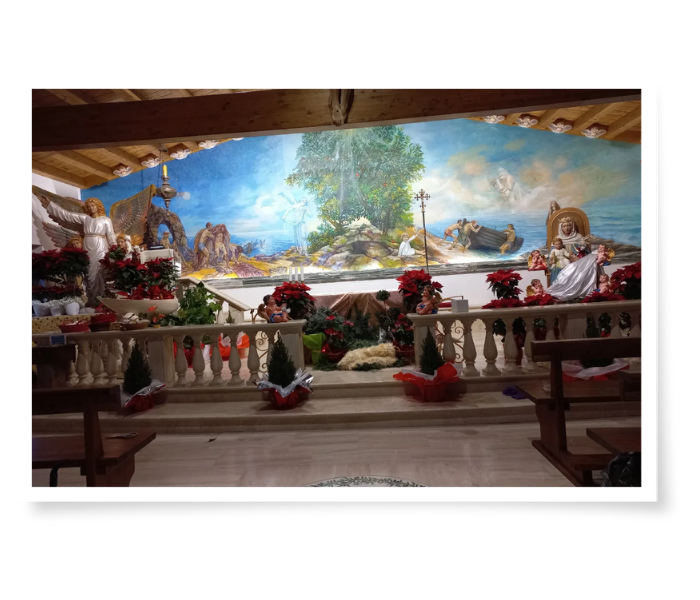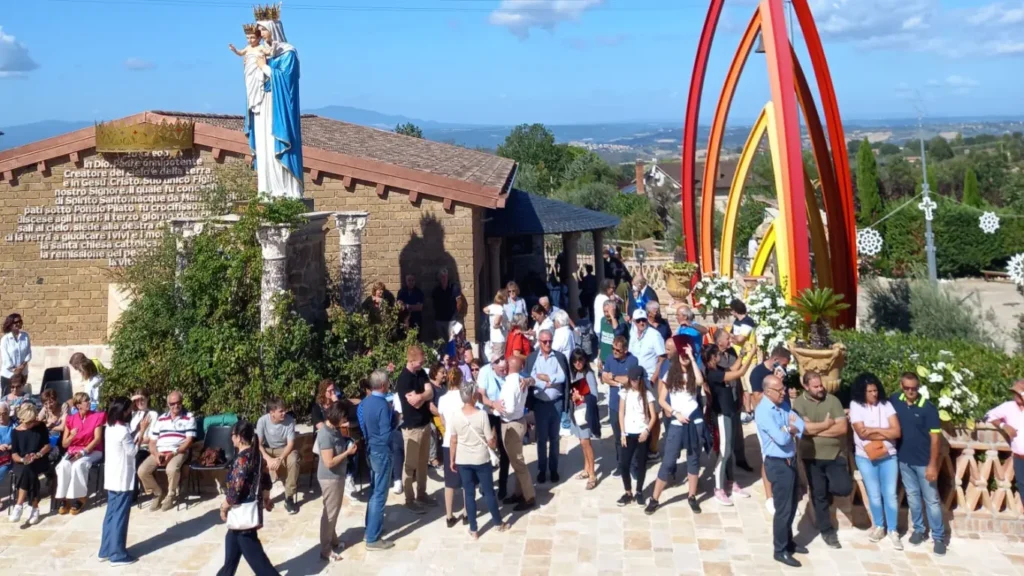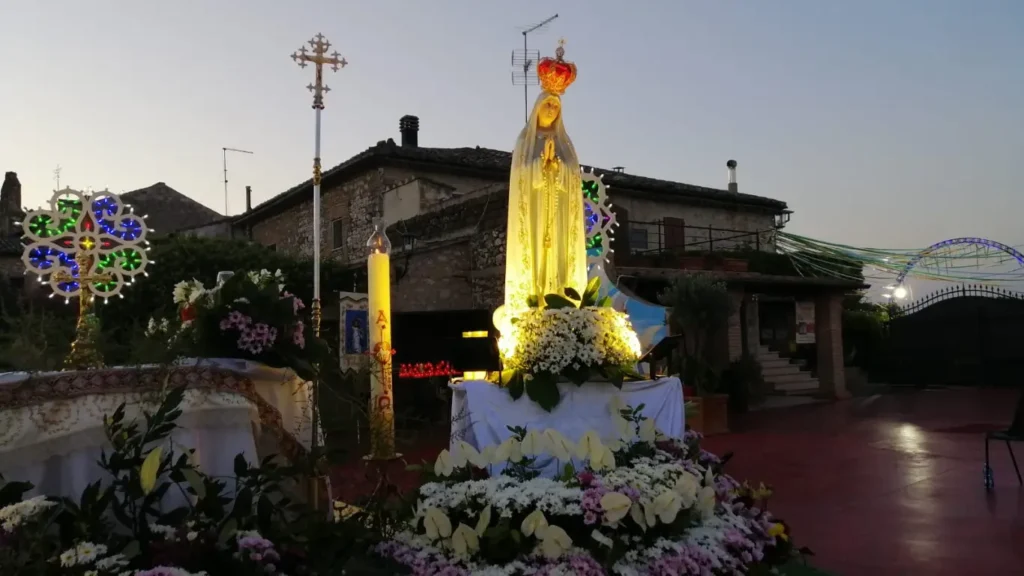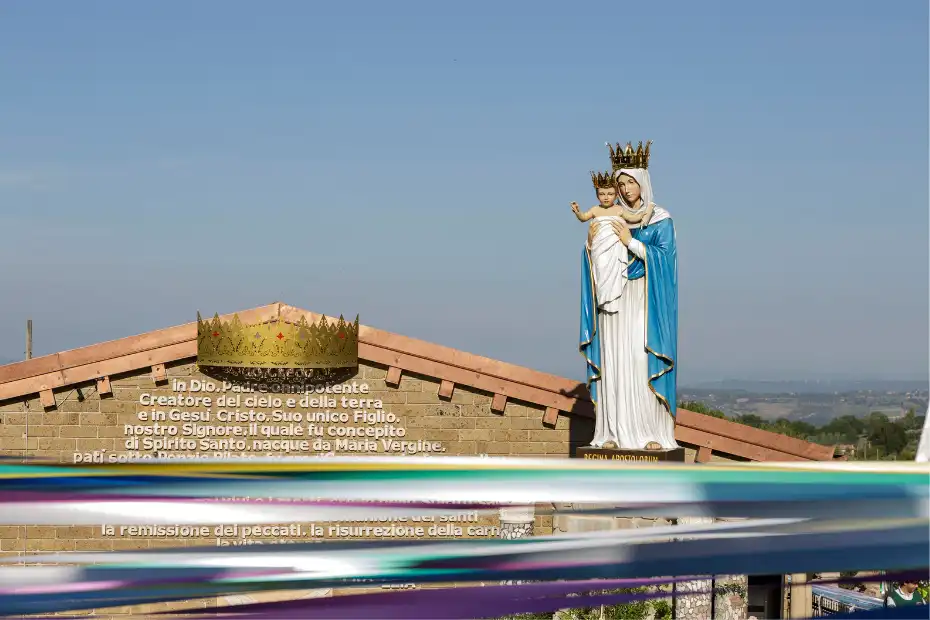
Convent Frà Elia. History of an ancient place
A place of worship and prayer visited from thousands of pilgrims every year.
The history of the convent goes back hundreds of years. After numerous renovations, which also took place thanks to various donations received, the convent today appears as a place that is completely estranged from the outside world. A place where pilgrims can find themselves and find inner peace through prayer, following the way of the Lord.
Father Renè Laurentin wrote: “It was a rejuvenation for me to spend time among the old stones of the convent to which Fra Elia has restored order and life… one can feel the breath and the breath of another world, another life, they are load-bearing places, confirming faith and hope.”
San Bernardo from Calvi: the Convent history
“Numbering just 600 souls in the 13th century, Calvi dell’Umbria, a tiny town in Sabina (which would enter politically into the Umbrian orbit only in 1827) capable, however, of being the birthplace of two great figures in Franciscan history: one of the first saints and one of the first bishops. Berardo da Calvi, counted among the Franciscan protomartyrs, killed in Morocco in 1220 together with four other friars from the present diocese of Terni Narni Amelia (Ottone Petricchi da Stroncone, Adiuto da Schifanoia, Accursio da Aguzzo and Pietro da San Gemini), Berardo would become one of the first saints of the order founded by Francis of Assisi.
… A young nobleman, Berardo had prostrated himself at the feet of Francis so that he would connote him among his disciples.
… The seraphic Father, in going to Rome several times, took a shortcut through the mountains, several times, making his abode in Calvi. Incidentally, a shortcut already known in the time of the ancient Romans, when Julius Caesar used to pass through it with his legions, so that a valley of Mount St. Pancras is still called “Julius Caesar’s.” And below Mount San Pancrazio is Casti-um Carbi (this is the Latin name for Calvi). From here there was a military camp, and an ancient Roman road passed by, leading to the town of Foronovo in Sabina, and here a shortcut to other roads to Rome; on its remains now stands the Sabine cathedral of Vescovio.
On one of the journeys to Rome the seraphic Father Francis, towards the end of the year 1213, preached to many people gathered in the little valley below Calvi, called San Salvatore, and in particular to the refugees from the castles of Altaino (facing the town) and Striano, which had been pulled down at the behest of Pope Innocent III because heretics of the Cathar and Patarine sects had taken refuge there (the year 1209 of Our Lord Jesus Christ then running).
“The house of St. Berardo above the high cliff, overlooked the valley below known as the valley of St. Savior …”
After priestly ordination, Berard had become a great preacher in the Arabic language. This probably need not have been his only trip to the land of the Saracens. A hero and the country’s main religious landmark, after his death the convent where Cataldo Elias, the alleged stigmatic known as “Fra Elia,” lives today was named after him. But Berardo does not remain the only great Franciscan born in Calvi.
In the years that passed from the town of Calvi came another great Minorite: Nicholas, who in the mid-13th century became bishop of Assisi.
Narrates Antonio Cristofani in Dalle storie di Assisi: “In 1247 the chapter of our cathedral, with the assent of the cardinal of Sant’ Eustachio, papal legate in Umbria, elected bishop Crescenzio of Jesi, state general minister of the Friars Minor, who did not obtain the sanction of Innocent IV. And in place of the refused, he deputed that same year that pontiff to the reign of this church another minorite, Nicolo di Calvi, his chaplain. But he could not take possession of the chair before 1250 because of the contumacy of the clergy, obstinate in defending the first election, or turning to the imperial side during the absence of the pontiff of Italy.” “In 1258 St. Bonaventure intervened in the donation made in Bevagna, to the same order, in the church of St. John. He had a difference with the abbot of Nonantola concerning jurisdiction over the priory of Valfabrica.”
Of Nicolò da Calvi – who would also write the life of Pope Innocent IV – we do not know exactly the year of his death. Cristofani himself, however, relates that in 1273 the canons of the cathedral chapter had elected Nicolò’s successor at the head of the Assisian diocese, and once again it was a Franciscan: Friar Illuminato of Chieti … “
The church of St. Francis and the convent of St. Berardo stand about 500 meters from the walls of Calvi dell’Umbria, on a hill ridge dividing the valleys of Otricoli and Magliano Sabina, at the junction of the old road to Narni.
According to tradition, they were built on land owned by the family of St. Berardo, a young Calvese who, captivated by the preaching of the Poverello of Assisi passing through the village in 1213, followed him and, sent to bring the Gospel to Morocco, suffered martyrdom there along with four other brethren.
Of the primitive church, originally dedicated to St. Victory, and the adjoining small oratory there are documentary records from 1291. Of the original architectural complex, the north wall, the church facade and the small oratory are currently preserved. The latter, consisting of two rooms, one of which is elevated, was incorporated into the building after the fire and looting perpetrated by the Lansquenets in 1527.
The church, built of local limestone, oriented in the canonical manner, restored several times during the 17th and 18th centuries, has a square facade surmounted by a tympanum with the unusual presence of a single barrel-vaulted hall with 10 side chapels, and preserves inside valuable paintings currently transferred to the Parish of Calvi because the church is still under restoration.
The small square in front of the church leads to the square cloister with, in the center, a 13th-century well, on the walls of the remains of frescoes from the second half of the 17th century depicting scenes from the life of St. Francis.


History of the convent through the years
- 1213 – St. Francis passed through Calvi, preached there and called to his religion a young man named Berardo who donated some of his land outside the town walls to erect a church and a convent. In a document of 1613 we read that during the time Francis remained in Calvi, the saint dwelt in a small church San Vittoria, which was then by the Calvesi, while the saint was still alive erected a church with a convent …
- 1291 – Nicholas IV grants indulgences, by papal bull, to some Franciscan churches, among which that of Calvi is named.
- 1330 – In the list of existing Franciscan friaries in the province San Francisci, Custodia Narnensis, left to us by Paolino da Venezia, we find Carvi – um.
- 1367 – In a translation from Latin of a parchment of the statutes of Calvi of 1367 we read, “We establish that every year be bought and given to the Friars of St. Francis in Calvi, half a hundred tiles to repair the convent of St. Francis, the church of St. Victor and the house of the place of St. Francis. The treasury is required to buy said tiles at the expense of the town of Calvi and to give them to the Friars of said place …”
- 1399 – The friary is listed in L. Wadding’s Annales Minorum
- 1612 – Letter to Cardinal Lante … from the guardian of the community of St. Francis because the convent threatens ruin and is in need of restoration along with other things that are needed, so since the fraternity is poor it cannot afford such a burden …
- 1612 – Letter to Mr. General of St. Francis. Still reiterates the need to restore the convent even though there are no funds to do so. In addition, the letter denounces the friars’ desire to enlarge the church, which is no longer able to accommodate the faithful who attend it.
- 1615 – Letter to Mr. Domofonte Ferrini … for the necessity of the convent there would be need of a thousand scudi, to finish the repairs and make it habitable; as well as to provide the sacristy for the things necessary for the divine offices and finally to redo the enclosure walls surrounding the site …
- 1615 – Letter to Mr. Domofonte Ferrini … and well to narrate to the Pope that the church in two fronts has made an opening and it is necessary to make spurs or even redo it …
- 1665 – Request for help from the fabricators of the Church of St. Francis of the Convent of Calvi … to finish turning the Church …
- 1693 – Description of the right altar in carved wood and request for the necessary for the celebration of the Holy Sacrifice …
- 1702 – Granted thirty scudi to restore the ancient organ …
- 1810 – The Convent and all property of the Monastery of St. Bernard of Calvi are leased …
- 1815 – The Religious of the Convent of St. Bernard of Calvi expose the severe straits in which they find themselves due to the scarcity of the season and the readjustments still needed to the Convent …
- 1890 – The Church of St. Francis becomes the Parish of St. Valentine and all the paintings in it, including the bell, are transferred there …
- 1891 – Pastoral Visit: … there is the possibility of buying back the Convent but the asking price and the restoration work to be done do not permit such a step …
- 1900 – Pastoral Visit: … the convent is in urgent need of restoration. The roofs and the church are the most urgent …
- 1910 – From a photo of the time appears the Church of St. Francis with the rectangular window open in the center on the facade …
- 1919 – The mayor of Calvi directs that the repair of the damage caused by the 1915 earthquake to the church of St. Francis be facilitated …
- 1927 – From the report sent to the Sopraintendenza dell’Arte Medioevale e Moderna dell’Umbria it is pointed out that not much remains of the primitive construction but it is still possible to make a restoration of certain parts and also of the facade with relative consolidation of the building … Also urgent are the cleaning of the frescoes of the cloister and the restoration of the three paintings of the coming of the Holy Spirit, of St. Berardo, of the Martyrdom of
- Saint Pancratius …
- 1941 – Roof Repair …
- 1945 – Restoration work carried out as a result of war damage …
- After this date there followed dark years in which nothing important happened that would affect the history of the monastery, indeed it seems to have been completely abandoned. In recent years, according to the people of Calvi, the Cloister of the Convent was the object of vilification of all kinds, and it was in its most advanced state of decay that Fra Elia first saw it in January 2003.
- 2003 – On July 19 Fra Elia and two other friars take possession of St. Berardo friary. On Oct. 23 they take up permanent residence there at 11 a.m. On Nov. 04 after copious rains had ruined part of the suspended ceiling, showing the condition of the interior of the roof of the north wing of the friary; repair work offered at the time by a benefactor from Brescia began. Initially, these works were to consist only in a partial repair of the deteriorated parts, but after a thorough inspection seeing the desolating sight of the condition of the whole building, conservative restoration and consolidation works began. Work that still continues today. The Convent, however, has now been restored to its former glory, described by Fra Elia as ” … a royal crown for God … ” and returned to the dignity of a place of worship for which it was originally built.
Back in the year 2004…
These photographs were taken in the year 2004 and show you what the convent looked like before the work that was done in later years.
At the time, the structure was dilapidated, a pile of rubble. With time and hard work, the fraternity managed to restore the convent to its former glory.
Works to be completed at the Calvi Convent
When Fra Elia together with his first brothers took up residence at the convent in Calvi, they found only a heap of rubble, crumbling walls, a crumbling roof, stairs buried by debris; in these 18 years much work has been done exclusively with the help of divine providence… He transformed the stable into a beautiful church, a grassy field into a square with an open-air altar. He built toilets… made a large garden of olive trees to welcome pilgrims in front of the altar… and much more… Unfortunately, the work is a lot and the workers are few but, despite the inconveniences, the work continues.
There are still important projects to be completed, among the most urgent : houses for families, the guesthouse, the Way of the Cross and….finding water underground
THE PILGRIMS’ HOUSE. This facility has been under construction for some time and will be able to accommodate 30-40 people initially, but more than 50 people in the future. The plan is to host people for a 2 to 3-day program of spirituality gatherings through spiritual exercises, retreats, thematic discussion days, meetings with young and old, family gatherings, and more.
VIA CRUCIS. To complete the spirituality center, Fra Elia, at the Lord’s suggestion, will create a thirty-five-station Stations of the Cross with human-sized statues…Way of the Cross of Jesus and Mary. It will extend over an area of about 3 hectares along the large grassy slopes at the foot of the convent and in the valley to the northeast. The lush nature of the place totally sheltered from annoying noises will allow pilgrims to rest their minds, find peace to concentrate solely on the needs of the spirit.
UNDERGROUND WATER. Water is a source of life, purifying and saving. The symbolic meanings attributed to water cross the centuries, peoples and different cultures while maintaining significant similarities.
Water has always had deep sacred significance. In most religions, as well as in Jewish worship and Christian denominations, the use of water refers to a purification process.

















